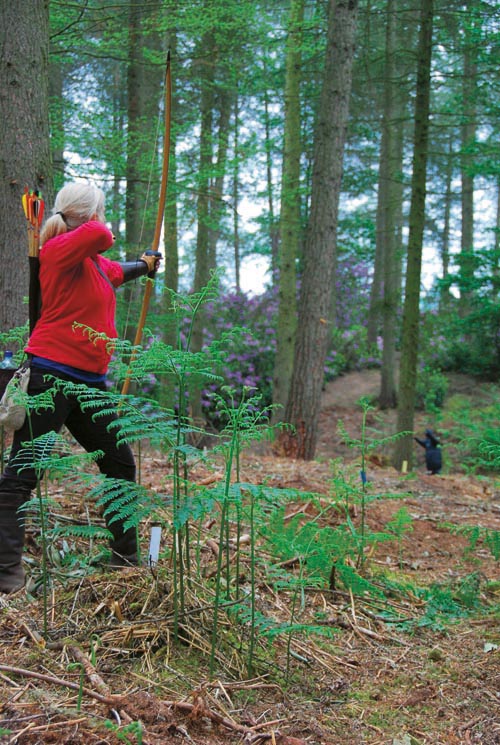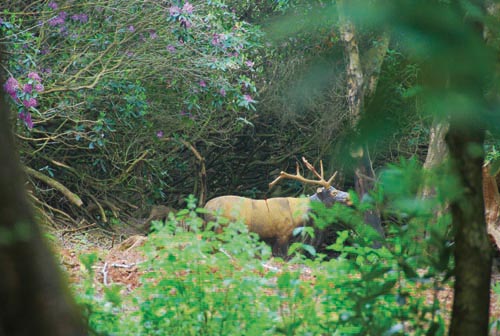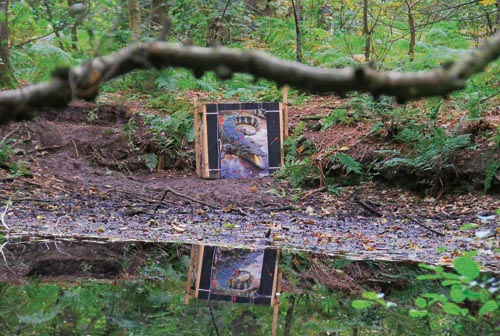Variety is the hallmark of the National Field Archery Society (NFAS) – whose shoots are highly competitive affairs – but with a strong element of family participation. There is also a vibrant, social atmosphere that acknowledges the fun involved in meeting the course-layer’s challenge, which forces archers to judge the size and distance of their target before taking every shot.
Within NFAS, courses are always shot over unmarked distances in woodland. The level of variety among shooters means that, when you ask any group what makes their perfect NFAS course, you’ll normally get as many answers as there are archers. However, the most popular round shot, and the one used at championships, is Big Game. This term refers to the scoring system used, rather than the animal targets, which can be either 3D rubber or paper. These range in size from 3D rabbits – or slim stoats on a paper face – all the way up to life-size 3D elks and bison.
A standard Big Game round consists of 36 or 40 targets. Archers shoot up to three arrows until they hit each target, shooting with their leading foot behind red, white and blue pegs of decreasing difficulty (but decreasing points), and finally scoring a blank (or zero) if the third arrow misses. Typically, the highest scoring red peg will be furthest away, but it may also have an obstructed view, or require the archer to change stance, while always keeping their leading foot on the peg. They may potentially have to kneel down to find a clear window.
The white peg generally presents an easier shot, while the blue peg gives everyone a chance to score. For each shot, more points are awarded if the arrow hits the ‘kill’ zone of the animal, which is a small area normally representing the heart and lungs. If it hits the rest of the animal, it is considered a ‘wound’, which carries a lower score. Under-16s and under-9s have their own pegs closer to the target, to provide suitable shots for lower- poundage bows. Each shot therefore has five separate pegs.
 A course-layer has two choices when planning the shots: where to put each target, and where to set the progression of pegs. The first decision must take participant and public safety into account – with due consideration for access routes. This will influence the basic layout, and the paths chosen around the wood. With bows shooting a maximum of 300fps under NFAS rules, targets must not be set too close together, and should include a clear area to each side in case of a ricochet, and an overshoot area behind.
A course-layer has two choices when planning the shots: where to put each target, and where to set the progression of pegs. The first decision must take participant and public safety into account – with due consideration for access routes. This will influence the basic layout, and the paths chosen around the wood. With bows shooting a maximum of 300fps under NFAS rules, targets must not be set too close together, and should include a clear area to each side in case of a ricochet, and an overshoot area behind.
For NFAS championships, there are additional considerations where multiple courses are set within the same grounds. Championship courses must be a real test of an archer’s skill – but organisers have to ensure that courses do not overshoot one another, and provide safe exit routes for archers leaving one course while others are still shooting.
Once these factors have been accounted for, a course-layer then has complete freedom to decide where to place the targets, and what sizes to use. Shooting lanes to targets don’t need to be clear from branches or other obstructions, giving further scope for placement. To make a course enjoyable, shots should be achievable and interesting for all ten permitted styles of bow and arrow – from primitive bows shooting wooden arrows, through unsighted bows, to sighted compounds and recurves.
Because all NFAS distances are unmarked, simply adding distance to a shot does not necessarily make it more challenging. A longer shot where the archer has a clear view of the target may be less challenging than a shorter shot where the target is partially obscured. Similarly, large variations in distances between adjacent targets will be harder to judge, so a grizzly bear at 80 yards followed by a pheasant at 10 yards will be more challenging than shooting two targets at similar distance one after another. At NFAS Championship courses, shots are normally set no further than 65 yards away – and still manage to test arches of the highest calibre, as the distances are hard to judge.
The terrain may also make judging distances challenging. Where a wood has inclines, setting a target above or below an archer will foreshorten the apparent distance. Similarly, if the approach to a target includes dead ground, such as dykes, pits or streams, the target will appear closer than it is, particularly if these features are hidden when viewed from the pegs. Conversely, setting a target in an open area with no features to measure against provides a different experience.
Even in a flat wood, there are opportunities to use the natural features to make shots challenging. Setting targets in gaps between trees, or through the fork of two branches, is common practice. Foliage, tree stumps or grass can be used to obscure parts of the target, making its size more difficult to judge. This can prove especially challenging for lower-poundage bows, where there is a pronounced trajectory on longer shots, and overhanging branches in the lane can deflect arrows. Understanding where the light falls can also be crucial to a shot. For example, if a target is under a dense canopy in deep shade, it is much more difficult to determine the location of the kill area.
Certain locations seem to suggest specific targets – resulting in a shot that is both tricky and natural-looking, though, of course, you might be shooting some animals that are thankfully not found in an English wood. The sloping edges of a pond may host a crocodile to be shot across the water. A patch of grass in a clearing might make a good place to put a grazing deer target, and a badger may look at home in the hollow at the base of a fallen tree. Given that all archers will be aiming for the kill on the animal, this must be visible from the pegs, but angling the target so that a smaller proportion of the kill zone is visible will test the best archers in order to get those extra points.
The hallmark of a well-laid course is an archer’s admission that they missed the target because they had been deceived by the shot, rather than through poor technique. Of course, the biggest reward for the course- layer is lots of people booking in for their next open shoot.



